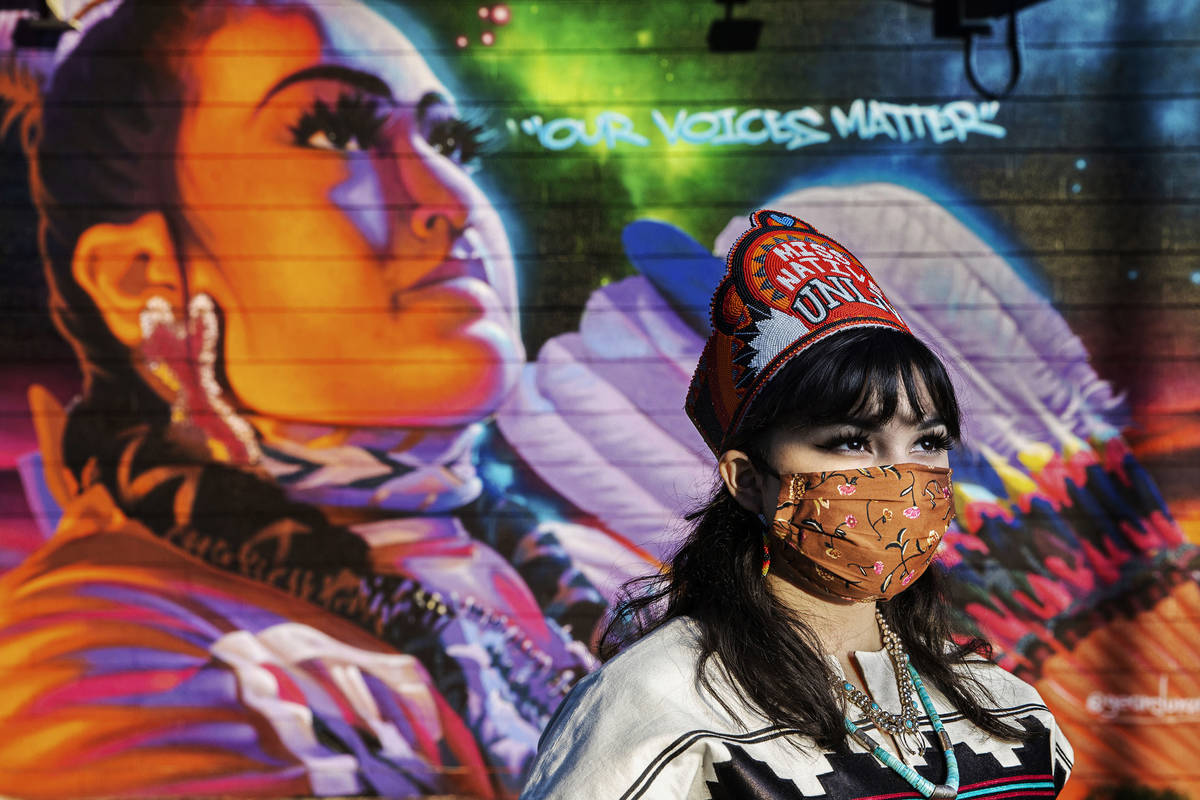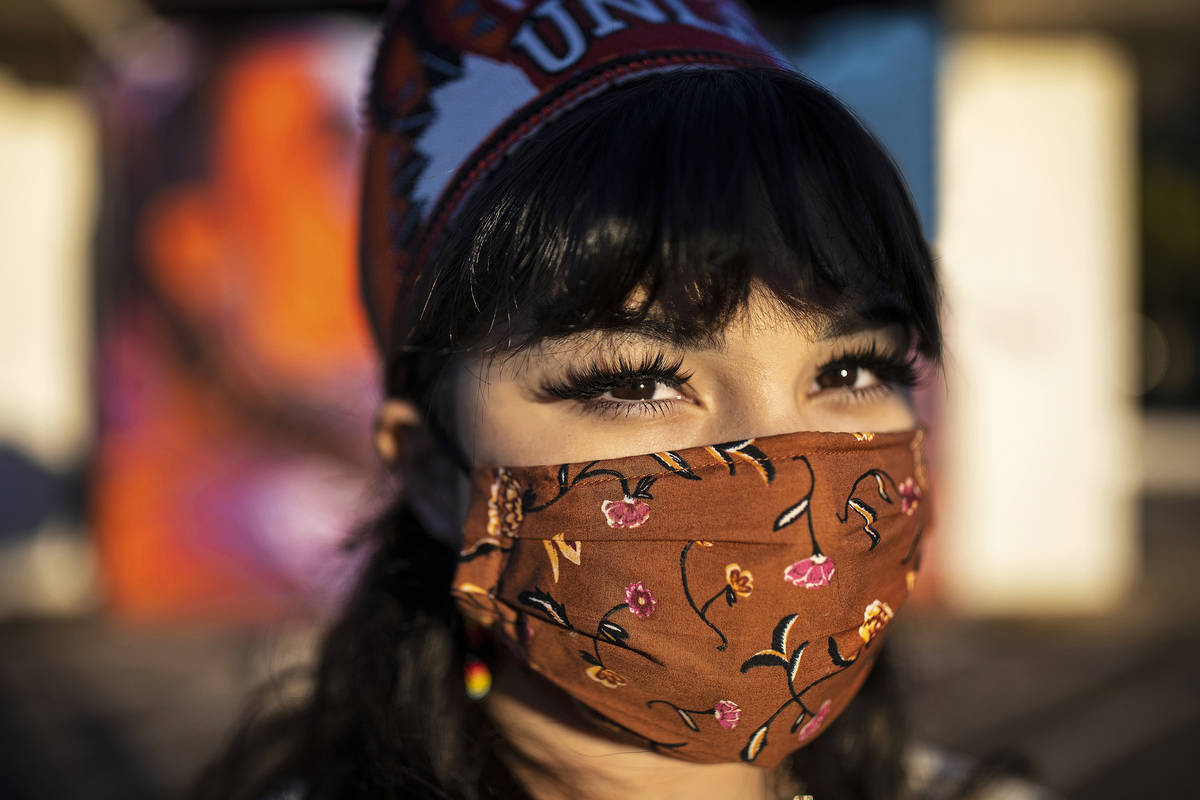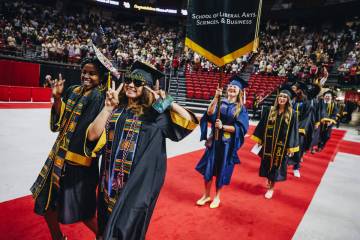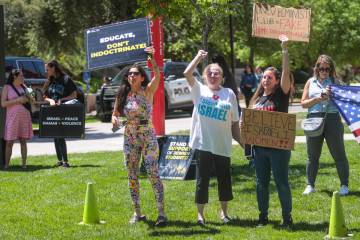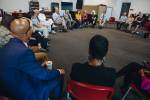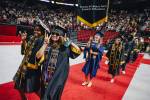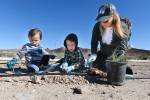Mx. Native UNLV focused on healing indigenous community
Annika Roseen is on a quest to regain what has been lost in her culture. Now, she’s doing it with the Mx. Native UNLV title.
On Oct. 18, Roseen was crowned Mx. Native UNLV for 2020-21 in a pageant created by the UNLV Native American Student Association as “a platform for indigenous leaders to spark meaningful change on important issues.”
A psychology major and junior, Roseen, 21, identifies as queer and is an advocate for mental wellness in the indigenous and LGBTQ communities.
“She’s like a royal activist who gets things done,” said Jonnette Paddy, who in 2018 was crowned Miss Native UNLV, the pageant’s name prior to 2020. “It’s nice to see someone like us doing incredible things. It’s inspiring for the community. It breaks stereotypes of how other people view us.”
Roseen said this year she suggested changing the name to Mx. Native UNLV to welcome all members of the indigenous community regardless of gender.
In Roseen’s pageant submission video, in which each contestant was asked to showcase a traditional talent, she sang “Amazing Grace” in Navajo. She said that language, indigenous history and tradition fades with every new generation.
“I notice that young people know less and less about where they come from,” Roseen said. “I saw it in myself, too. I wanted to reclaim those things.”
In an interview at the Las Vegas Indian Center, 2300 W. Bonanza Road, Roseen stood in her traditional Navajo “biil” dress and beaded Mx. Native UNLV crown. Around her waist she wore a red and green sash belt that she said “signifies womanhood and fertility.”
Her charcoal hair draped against her shoulders like curtains, revealing her multicolored beaded hoop earrings, which she said her grandmother gave to her from a reservation in Shiprock, New Mexico.
Roseen said that while she is proud to be Navajo, she didn’t always understand what that meant to her. She has been on a journey in recent years to discover more about who she is and her relationship to her culture.
”Natives are grouped into generalizations often,” Roseen said. “I got sucked into a lot of, ‘This is what it means to be Native.’ I didn’t see a lot of room to make it my own.”
‘Trying to figure out a lot’
From 1999 to 2015, Roseen and her parents moved often. Her father’s mining job took them to New Mexico, Utah, Papua New Guinea, Singapore and Australia.
Throughout her many moves, she attended Navajo language classes with her mother, explored Native American art and visited her grandmother in Shiprock during summers.
In 2015, after living in Singapore for three years and then Albuquerque for one year, Roseen and her parents moved to Henderson. By high school, she was dealing with mental illness, exploring her sexuality and learning what it meant to be a Navajo woman.
“I was trying to figure out a lot,” Roseen said.
In her classes, she would introduce herself as a Navajo.
“It was exotic to them, but it didn’t go any further than that,” Roseen said. “I didn’t really know what being Navajo meant to me. I felt that every time I moved someplace new, I’d need to mold myself to fit the environment.
After many moving boxes and feeling like she had nowhere to “root herself in,” she realized one thing that remained constant: her culture. After this realization, she began digging for information about her roots.
‘Make my culture suit me’
In 2018, Roseen read the novel “There There” by Native American writer Tommy Orange. She said when she started reading the book and learning more about urban Native American culture — in big cities or away from the reservation — something inside of her was awakened.
“It felt like a whole different culture that fit me right,” Roseen said.
Her voice amplified as she began to describe the book: “The writer said something like, ‘Imagine sidewalks as your native terrain. You’ve survived death and culture removal. Now, you’re reclaiming these nonnative spaces as yours because you were resilient enough to be there.’”
“After reading that, I realized I needed to find ways to make my culture suit me instead of trying to make me fit a concept of what it means to be Native,” she said. “I think many young people in my community struggle with this.”
After struggling with mental health and family issues, she decided in 2019 to contribute to organizations such as the Native American Student Association and the National Alliance on Mental Illness.
“We deal with many awful remnants of cultural assimilation and genocide leading to a dependency on negative coping mechanisms like alcohol and substance abuse,” Roseen said. “I witnessed it in my family. I knew I wanted to do more about it.”
Mental health reform
Now, Roseen dedicates herself to several organizations in hopes of amplifying indigenous voices and promoting mental wellness, inclusion and educational reform within the indigenous community.
In July, Roseen created a Native American event with the National Alliance on Mental Illness, during Minority Mental Health Awareness Month. The event was a discussion-based panel to educate about barriers Native Americans in Southern Nevada experience and how they can be supported in accessing resources and help.
She said she’s starting to work on a mental health project with the Nevada Statewide Native American Caucus to help reform mental health crisis response in tribal areas. She also is hoping to increase awareness for queer Native community members next semester. She plans to create a Native American council under the Womxn of Color Coalition in spring.
“You don’t need to be a ‘traditional’ person in order to call yourself Native,” Roseen said. “If you’re indigenous, you’re indigenous. There’s strength in that.”
Contact Mya Constantino at mconstantino@reviewjournal.com. Follow @searchingformya on Twitter.



